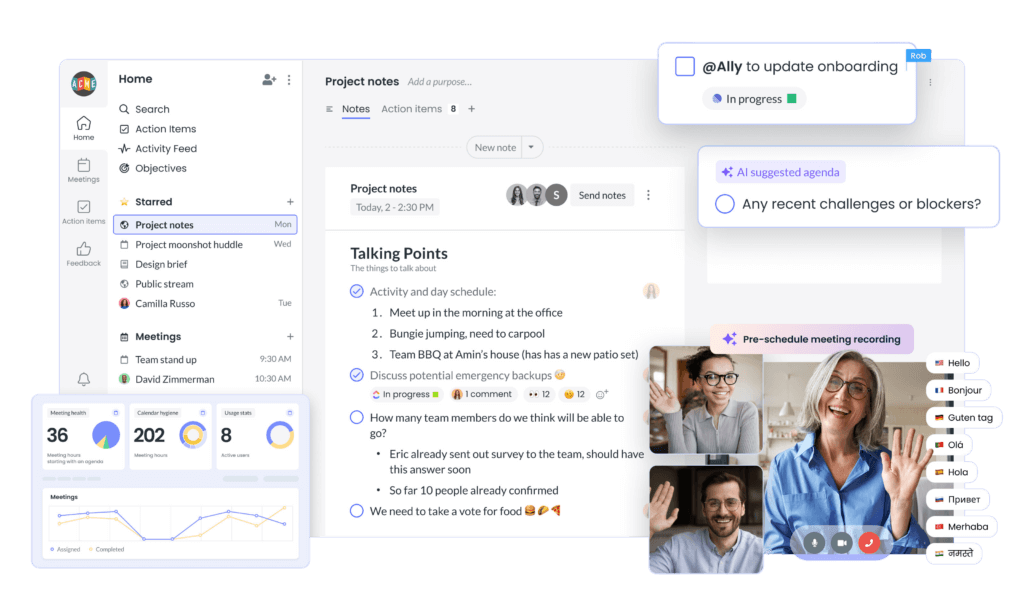Program Management: 8 Tools and Software for 2024
Check out these top program management tools that can make all the difference in managing your organization’s many projects.
At any point in time, your teams might be involved in several projects. From building a website to putting a marketing plan together or launching a new product, keeping up with these projects requires careful coordination.
This is where program management comes in—it’s how you find the perfect balance among your organization’s many projects. Program management software unites all the handy features you need to streamline collaboration, track progress, and meet your project goals. Below, you’ll find some of the best program management tools to enhance your processes and boost overall efficiency.
- What is program management?
- What does a program manager do?
- Program management vs. project management
- The benefits of program management
- 8 tools for program management
- Achieving excellence with Fellow
What is program management?
Program management is the process of overseeing several related projects to make sure they work well together. Maybe these projects tie into the same strategic goal, or maybe they’re how you’re working toward the same business objective. In any case, the main goal of program management is being efficient and making the most of your resources.
Program management involves planning, coordinating, managing, and executing your related projects while keeping them aligned with your organization’s vision and goals. The idea is to bring these projects together so they cohesively play a part in your organization’s success.

Stay synced with teams and projects
With Fellow, tackle program management with ease. Collaborate on meeting agendas, assign and sync action items with project management tools, and keep track of meeting decisions in one place, ensuring actionable outcomes in every meeting.
What does a program manager do?
A program manager is a coordinator who keeps multiple projects in sync throughout their life cycles. Below are some of the responsibilities you’ll find in this leader’s job description.
- Plan and oversee the program. A program manager comes up with a strategic plan for handling projects. This involves setting milestones, making timelines, and monitoring each project’s progress closely.
- Coordinate projects and interdependencies. Sometimes, part of a project needs to be completed before you can start on another. A program manager stays on top of these project management dependencies so that everything keeps moving smoothly.
- Draw up a budget and stick to it. Sufficient money for the project is a big part of the job, but overspending is a no-no. That’s why program managers create budgets, oversee financial resources, and ensure each project has the funding it needs.
- Manage resources across projects. From technology to equipment and employees, a program manager identifies each project’s resources and allocates them where they need to go. When more than one project needs big-time resources, the program manager finds ways to balance them among the projects.
Program management vs. project management
On one hand, program management is about the bigger strategy that goes into planning and organizing all projects within a goal. Project management, on the other hand, focuses on a single project.
Though their roles differ, program and project managers often work together. Program managers take a high-level view of many projects, while project managers oversee day-to-day tasks. In short, project managers make the plans that the program manager has set actually happen.
The benefits of program management
Below are some of the key reasons program management is important.
- Establish links between projects and overarching business objectives
- Recognize how projects are interconnected
- Streamline the distribution of resources
- Unite perspectives on risks and opportunities
Establish links between projects and overarching business objectives
If each project team does its own thing without a clear connection to the big picture, you might need a program manager’s help. This organizational leader takes each project’s objective and links it to your overarching business objectives. This way, you create clear links between projects that stakeholders and clients can easily see.
Fellow’s OKR feature allows your team to have visibility into and align with your organization’s objectives and goals, creating a culture of collective accountability and synergy. In Fellow, OKRs can be embedded in your meeting agendas, making it easier to stay aligned.

Recognize how projects are interconnected
The gears in a clock work together—when one gear is rusty or off track, the whole system gets hiccups. The same concept applies to your organization’s projects—what happens with one affects the other. Program management shows you how projects are interconnected and pinpoint their impact on your organization’s growth. Understanding these connections and how to manage them improves all-around coordination, efficiency, productivity, and cross-functional collaboration.
Streamline the distribution of resources
Program management makes sure the right amounts of labor, funds, and equipment are going where they’re needed. Resource management this effective means no more overloading one project while another is left struggling for support. This way, there’s balance across the board without you compromising on success.
Unite perspectives on risks and opportunities
You’ve probably been in meetings where everyone has different ideas about which risks are just too risky and which ones are worth taking. With program management, you get a clear picture of project constraints and the risks you can take without putting your progress in peril. No more guessing games—you’ll know how far you can push the envelope without plans falling apart. Plus, you’ll get everyone on the same page about the best approach to take.
8 tools for program management
Program management is about more than strategy and coordination. With the right set of tools, you can navigate several projects at once and take an adaptive approach to project management. Below are eight program management tools that make the whole process seamless.
1nTask
nTask is a project management tool that simplifies the process of managing several projects. It allows you to easily track your team’s tasks and deadlines. With Kanban boards and Gantt charts, you can visualize all your projects’ progress.
nTask gives you a dedicated space for tracking budgets and setting task dependencies. These features make complex project elements much more manageable. nTask also improves your team’s communication with chat features and document-sharing tools.
Features:
- Time tracking and timesheet reporting
- Task and sub-task management
- Software issue and bug tracking
Plans and pricing:
- Basic: Free for teams of up to five people
- Premium: $3 per month
- Business: $8 per month
- Enterprise: Custom pricing

2monday.com
monday.com works well for organizations of all sizes since it offers tools for working on projects both big and small. One of its standout features is its customizable workflows, which help you tailor project processes to what works best for your teams.
monday.com also helps you manage project intake and approvals while keeping a close eye on your resources. From keeping up with your team’s time to overseeing the technology you have on hand, monday.com is well-suited for big-picture program management.
Features:
- Real-time dashboards that show project details at a glance
- Buildable workflows that require no coding
- Automation functions that eliminate repetitive tasks
Plans and pricing:
- Free: For up to two users
- Basic: $9 per user per month
- Standard: $12 per user per month
- Pro: $19 per user per month
- Enterprise: Custom pricing
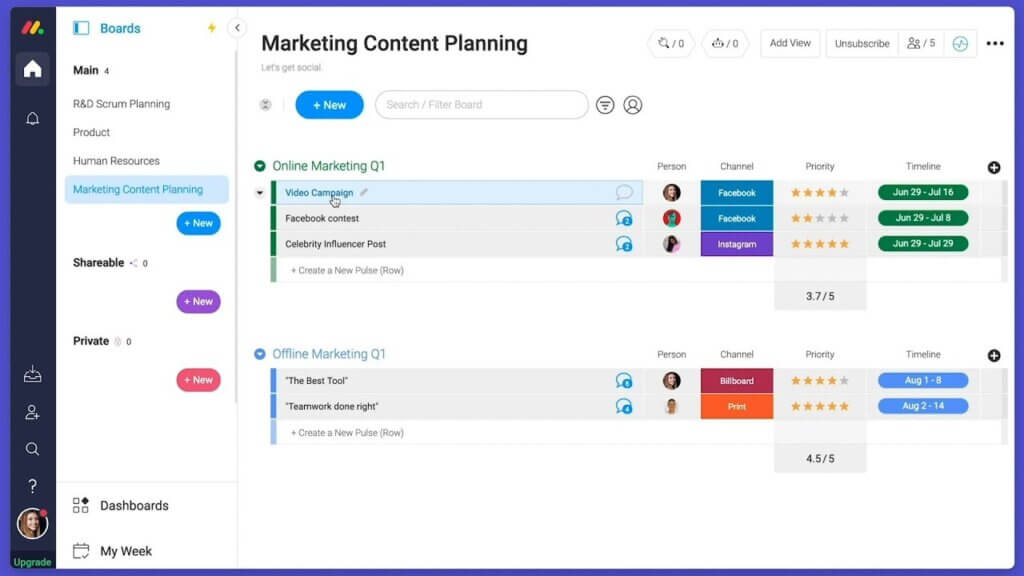
3Wrike
Wrike brings all your teams together within one app. Its quick insights show you how much time team members are spending on each project, as well as each person’s availability.
Wrike’s cross-tagging function lets you easily view tasks within projects and understand how they relate to the whole project. With detailed resource management, you can estimate the resources you need for each project and clearly track them with visuals.
Features:
- Integrations with many leading apps
- Cross-tagging for full task visibility
- Collaborative online proofing software
Plans and pricing:
- Free: For an unlimited number of users
- Team: $9.80 per user per month for three to 25 users
- Business: $24.80 per user per month for five to 200 users
- Enterprise: Custom pricing
- Pinnacle: Custom pricing

4Asana
Asana is where strategy and organization come together. It’s an especially useful tool for agile teams thanks to its collaborative setup, which is ideal for managing complex projects. This platform’s strategy planning features help you pinpoint the tasks and goals that will have the most impact. From there, you can set your priorities straight and direct your team’s attention to what matters most.
Asana neatly aligns all tasks within a project, giving you a straightforward view of how well your teams are progressing. This level of organization helps keep your projects on track and push efficiency at every step.
Features:
- Kanban boards track sprints and outline entire projects
- Task assignments show who’s responsible for each item
- Sub-tasks, comments, and deadlines are located in one place
Plans and pricing:
- Starter: $10.99 per user per month
- Advanced: $24.99 per user per month
- Enterprise: Customer pricing
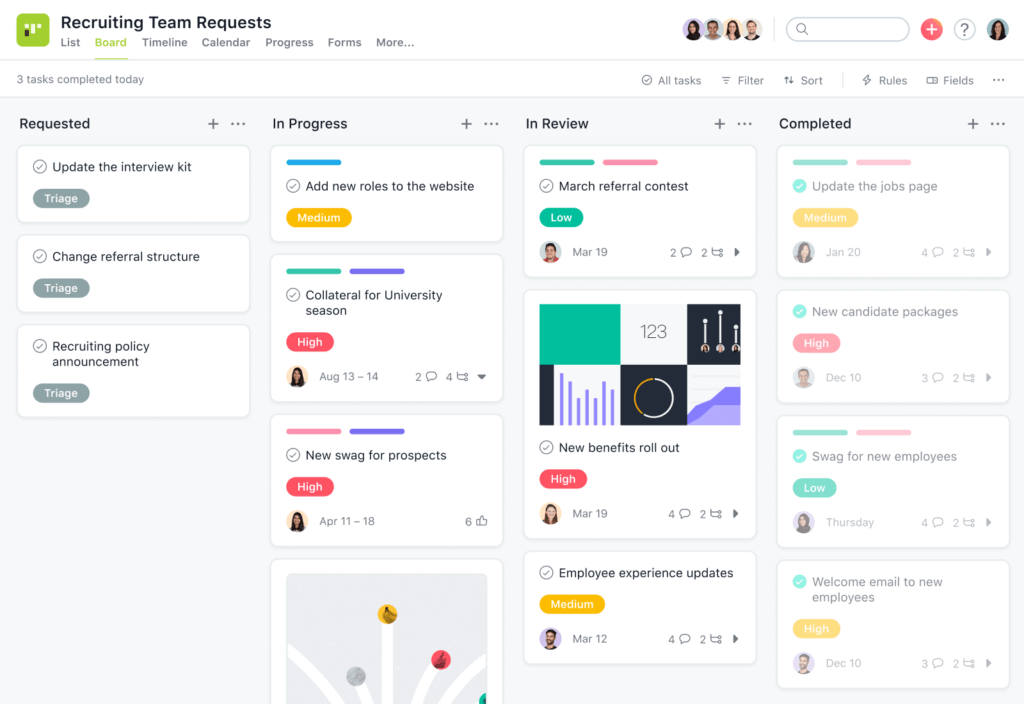
5Celoxis
Celoxis specializes in portfolio management and helps you gather and sort project requests based on your organization’s key performance indicators (KPIs). This way, you can prioritize the projects that bring the most value to your organization. Built-in scheduling and planning tools ensure everything is on track and running smoothly. Celoxis also makes it a breeze to manage dependencies between projects.
Features:
- Customizable dashboards
- Schedules that automatically adjust to external factors
- Revenue forecasting
Plans and pricing:
- Cloud: Custom pricing
- On-premise: Custom pricing

6ClickUp
It’s often best to lay out everything in front of you and create a plan from there, and ClickUp is a great tool for that. With ClickUp’s virtual whiteboard, you can draw out your ideas, map intricate workflows, and create a roadmap to completing your projects.
Charts and graphs show where your teams are having the most success and where bottlenecks might be slowing their progress. ClickUp also excels in cross-functional program management; you can easily share workflows and documents across departments.
Features:
- AI for automatically creating subtasks
- Templates for managing projects
- Real-time dashboards
Plans and pricing:
- Free: For an unlimited number of users
- Unlimited: $7 per month per user
- Business: $12 per month per user
- Enterprise: Custom pricing
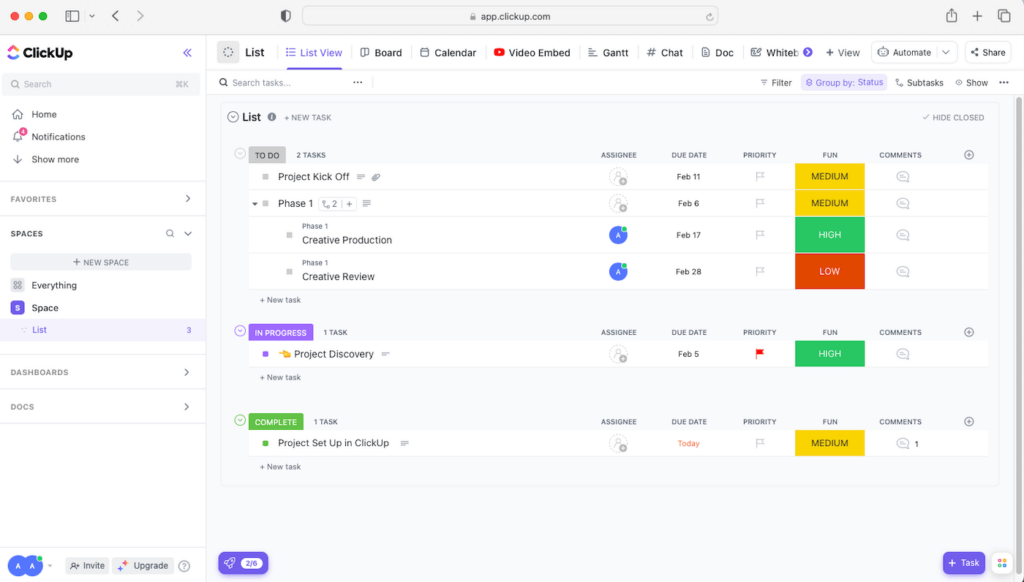
7Smartsheet
As you might have guessed by its name, Smartsheet offers sheets and charts for detailed, technical, and practical views of your projects. You can pull data from multiple sheets and create custom reports; the result is a full picture of what your teams are working on.
For a high-level view of all your projects, Smartsheet’s dashboards bring widgets, metrics, and reports together. This way, you get real-time insights into every project across all your teams.
Features:
- Plan insights for continuous account management
- Gantt charts that uncover task dependencies
- Analyses of historical data across projects via work insights
Plans and pricing:
- Free: For one user
- Pro: $7 per user per month for up to 10 users
- Business: $25 per user per month
- Enterprise: Customer pricing
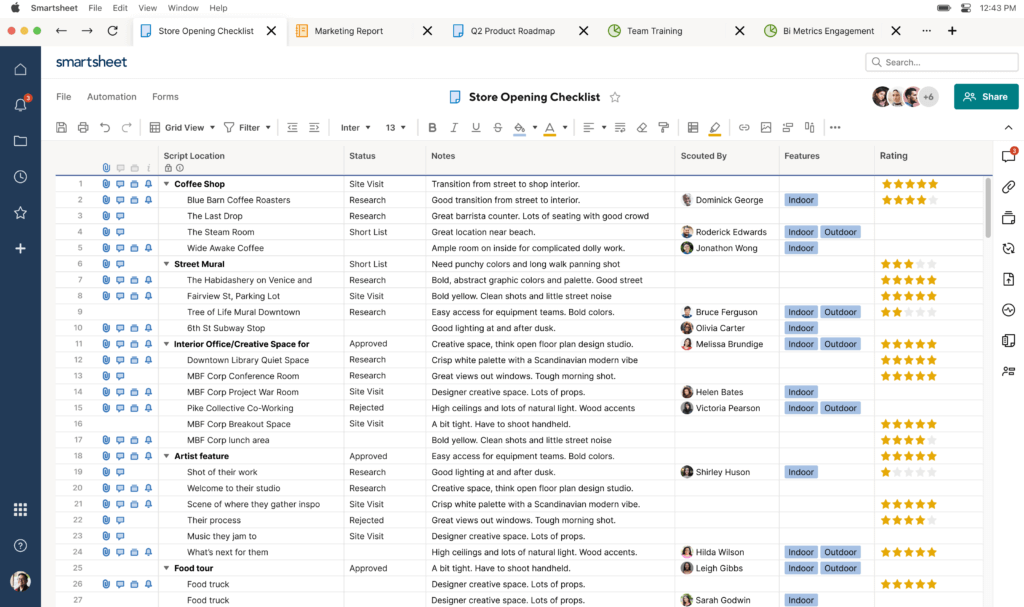
8Microsoft Sharepoint
Microsoft Sharepoint, which belongs to the Microsoft 365 suite of products, is a space for streamlined program management. Its focus is on file and document sharing and collaboration. Namely, you can use Microsoft Sharepoint to build internal websites where you host resources. There are also content management tools for storing and maintaining your organization’s knowledge. With these resources and this information, you power stronger program management.
Features:
- Integrations with other Microsoft products (for example, Word, Excel, and PowerPoint)
- Desktop app and online version
- Information lists and libraries
Plans and pricing:
- SharePoint (Plan 1): $5.00 per user per month
- Microsoft 365 Business Standard: $12.50 per user per month
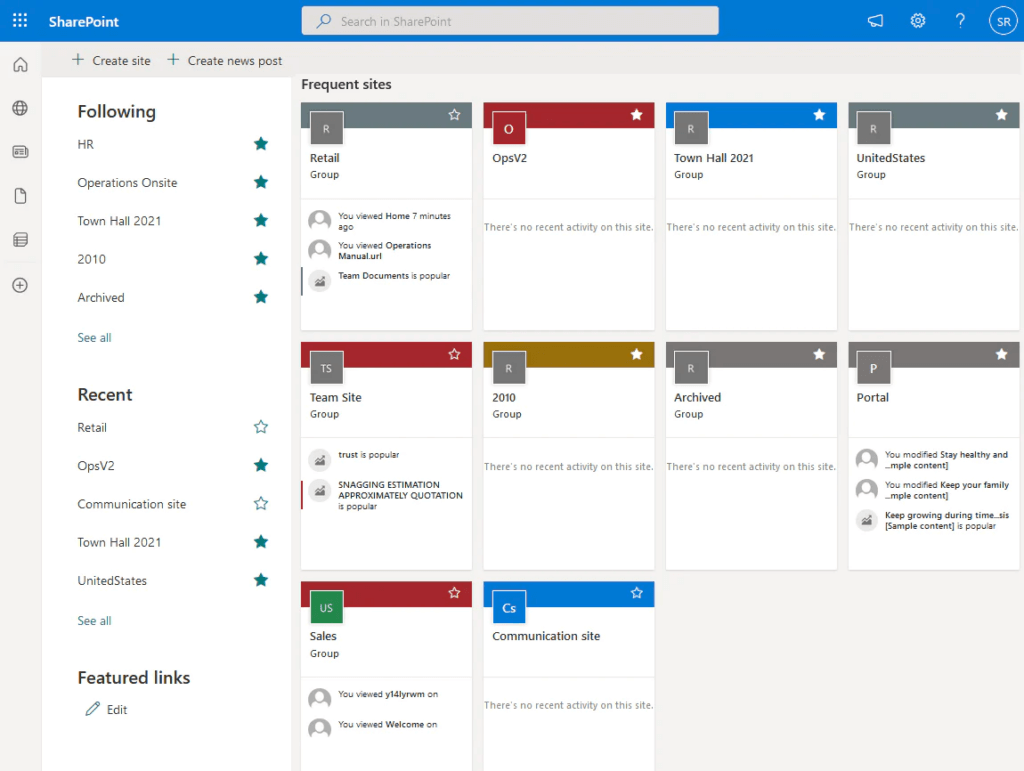
Achieving excellence with Fellow
Program management tools take the guesswork and hassle out of managing multiple projects. Once you’ve found the tool that works best for you, take your team’s communication to the next level with actionable, productive meetings that encourage collaboration.
After meetings, you can easily assign and track action items with due dates across different workflows, keeping everyone accountable for their tasks and your projects on track. Fellow also offers native integrations with your existing PM tools, ensuring that information is always synced and updated across your program.
Fellow offers hundreds of meeting agenda templates for planning meetings about pretty much any project. Whenever there’s a meeting on the calendar, use Fellow’s templates, including project implementation checkpoints, to invite team members to add talking points beforehand. You’ll get everyone on the same page—and get all your project requirements and plans fully covered.
